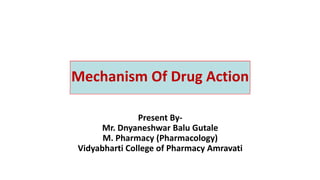
Mechanism Of Drug Action Explained
- 1. Mechanism Of Drug Action Present By- Mr. Dnyaneshwar Balu Gutale M. Pharmacy (Pharmacology) Vidyabharti College of Pharmacy Amravati
- 2. Introduction • A drug may produce its effects by a number of mechanisms like combination with enzymes, cell membrane or other components of a cell. • The action either be physical or chemical and are classified at four levels: • Molecular- Receptor, ion channel, enzyme, carrier molecules • Cellular-Transduction e.g., G protein, ion channel, enzyme • Tissue- Contraction, secretion, metabolic activity, proliferationSystem-CNS, CVS, etc.
- 3. Types of effects Local Effect When the drug effect occurs in immediate vicinity of application, this is known as local effect. Systemic Effect When the drug effect occurs away from the site of administration, this is known as systemic effect. Primary effect Primary effect is the effect for which the drug is administered or the treatment of the disease for which the drug is given Side effect All other effects occurring in addition are known as secondary effects. When the secondary effects are undesirable by the Patient, these are called adverse effects or side effects.
- 4. Mechanisms Most drugs act by altering the various body control systems, which may be receptors, enzymes or ion channels. These various mechanisms include: 1. Physical mechanisms 2. Chemical mechanisms 3. Drug-receptor interactions 4. Drug- enzyme interactions 5. Drug-channel interactions 6. Miscellaneous mechanisms
- 5. Mechanism of Drug Action – Physical Mechanisms • When the drug does not produce any chemical reaction or change in the cells of the body and the effect is only physical, the mechanisms involved are called physical mechanisms. • These includes: • Local Application- Emollients, Counter irritants, Massagers, pastes • Physically acting antacids- Milk, Mucin • Bulk forming purgatives- Bran, Ispaghula, Magnessium sulphate
- 6. Mechanism of Drug Action – Chemical Mechanisms In chemical mechanisms, drugs act by producing chemical reactions in the body. These include: •Chemically acting antacids- NaHCO3 • Chelating agents- Dimercaprol, penicillamine, desferrioxamine
- 7. Mechanism of Drug Action –Drug Receptor Interaction Receptor: Macromolecules protein in nature which are target sites for drugs. Most drugs have to bind receptors to produce effects. Receptors are located mostly on the cell membrane but certain intracellular receptors are found as well.
- 8. • The binding of drug with receptor may by of two types: • Reversible binding • Irreversible binding • In reversible binding, the bond between the drug and receptor is very weak ionic, hydrogen or van der wall. This the effect is short lived. • In irreversible binding, very strong covalent bonds are present, which prolongs the effects of drug. The effect continues until the drug is excreted or new receptor is generated. There are three forms of binding to receptors: • Agonists • Antagonists • Partial agonists
- 9. Ligands • Ligands are the endogenous substances, molecules or compounds which bind with receptors present in the body. • E.g. acetyl choline, adrenaline, noradrenalin, neurotransmitters like glutamate, aspartate and GABA. • They produce various effects and interfere with the flow of ions through channels called ligand gated channels. • Their action may: • Resemble with natural ligand • Block the natural ligand
- 10. Agonists • They are the drugs which when bind receptors, cause activation of receptors. • They have the capacity to produce chain reactions in the receptors which ultimately bring about the effects. • Agonists have two properties: 1. Affinity for receptor 2. Capability to produce chain reactions in the cells having capability of intrinsic activity or efficacy
- 11. • When drug binds the receptor, activation occurs, and the response gradually increases until it reaches the peak, then the response decreases, although agonist still binds. • This is due to desensitization of receptors, which might be overcome by removing the agonists from the receptor. • Example includes suxamethonium (succinyl choline), which produces relaxation of skeletal muscles
- 12. • Prolong contact of tissues with the agonists results in decreased number of receptors in the tissues called down regulation of receptors. • Example includes the patients suffering from bronchial asthma, in whom by prolong usage of beta agonists down regulation occurs. • This the effect is reduced.
- 13. Antagonists • A substance which interferes with or inhibits the physiological action of another. • They have two properties: • Affinity • Do not have efficacy or intrinsic activity • Examples include atropine, which is antagonist of acetyl choline. Propanolol is antagonist of beta receptors.
- 14. • The binding of antagonist with receptor is of two types: • Reversible binding • Irreversible binding • Reversible binding is also known as competitive antagonism. E.g. atropine. • Irreversible antagonism occurs when binding effect of antagonist is prolonged until drug is excreted or new receptor is generated. • Example includes phenoxy benzamine, which non- competitively blocks action of catecholamines at beta receptors. • Second generation H1 histamines are also non- competitive blockers.
- 15. Mechanism of Drug Action –Drug Enzyme Interactions • Drug enzyme interaction is similar to drug receptor interactions. • The drugs resemble the natural substrates, bind enzymes and cause change in their activity. • This may take place by: • Activation of enzymes • Inhibition of enzymes
- 16. • This combination of drugs with the enzyme may be: • Competitive • Non competitive Non competitive response is irreversible until new enzyme is generated
- 17. Non Competitive Inhibition • The effects of non competitive inhibition are prolonged. These include: • Irreversible anticholinestrases e.g., Organophosphate compounds • Aspirin • MAO Inhibitors e.g., Iproniazid, Phenelzine • • Proton Pump Inhibitors e.g., Omeprazole, Esomeprazole
- 18. Mechanism of Drug Action –Drug Channel Interactions • In drug channel interaction, drug interfere with the flow of ions through the channels specific for these ions. • These include the Na+, K+,Ca++ and Cl- channels. Examples include: • Sodium Channels:- Quindine Procainamide, Local anesthetic • Calcium channels: Nifedipine Verapamil, Diltiazem • Potassium Channels:- Amiodarone, sulfonylureas • Chloride Channels:- Benzodiazepines